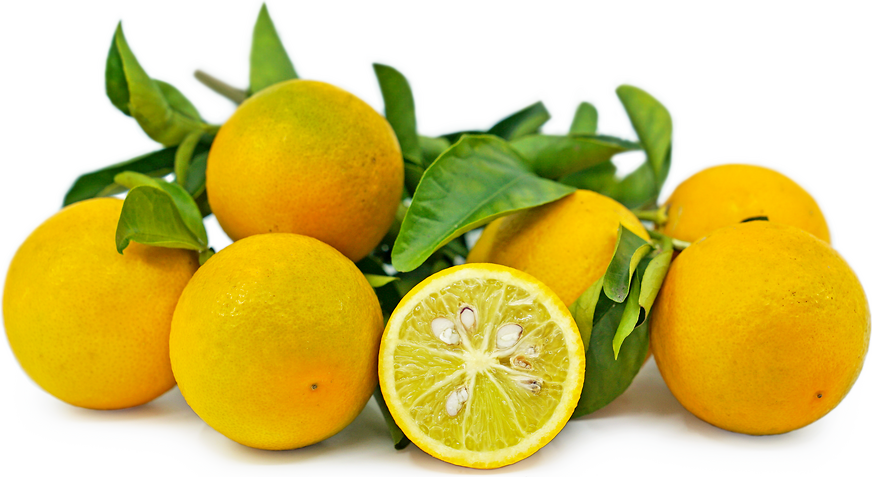


Flying Dragon Oranges
Estimated Inventory, lb : 0
Description/Taste
Flying Dragon oranges are small fruits, averaging 3 to 4 centimeters in diameter, and are round to oblate in shape, similar in size to a golf ball. The rind is semi-thick and lightly textured by small oil glands, ripening from green to yellow-orange, and is also covered in a downy coating, giving the surface a velvety, peach-like feel. Underneath the rind, the flesh is encased in a thin, white to pale yellow, spongy pith. The flesh is also pale yellow and soft, divided into 9 to 10 segments by thin, white membranes, and is filled with many cream-colored, oval seeds. Flying Dragon oranges are sour, acidic, bitter, and astringent, containing the tanginess of a lemon mixed with the bitterness of a grapefruit.
Seasons/Availability
Flying Dragon oranges are available in the fall through winter.
Current Facts
Flying Dragon oranges, botanically classified as Poncirus trifoliata, are an unusual, cold-hardy citrus relative belonging to the Rutaceae family. The small, sour fruits are a type of bitter orange that grows on a dwarf, deciduous tree or shrub reaching over six meters in height. Flying Dragon oranges are also known as Trifoliate oranges, a subcategory of orange trees that exhibit foliage growing in distinct, three-leaf groupings. Other popular names for the tart fruits include Flying Dragon Bitter oranges, Hardy oranges, and Japanese Bitter oranges. Flying Dragon oranges are primarily valued as an ornamental or medicinal plant and are also used as a natural fence. The fruits are not considered a “true citrus” by many experts, but the tree is one of the most cold-tolerant varieties that can be grown in climates typically unsuited for citrus production. The plants are also favored for their resistance to disease and small size, frequently used as rootstock for other citrus varieties.
Nutritional Value
Flying Dragon oranges are a good source of vitamin C, an antioxidant that strengthens the immune system, reduces inflammation, and boosts collagen production within the skin. The fruits also contain some vitamin A, potassium, calcium, and magnesium. In Asia, Flying Dragon oranges are used in traditional Chinese medicine to reduce inflammation and are believed to help with nausea and symptoms associated with allergies.
Applications
Flying Dragon oranges are edible, but the fruits contain very little flesh and have an extremely sour flavor, limiting the variety from being a fresh eating cultivar. The fruits are primarily cooked into syrups, jams, jellies, and marmalades, or they can be candied with high amounts of sweetener as a chewy snack. The rinds can also be utilized as a lemon zest substitute, cocktail garnish, or ground into a powder for use as a seasoning. In addition to cooked applications, Flying Dragon oranges can be stored for two weeks to develop a small amount of juice and then pressed to extract the liquid, flavoring citrus-ade, cocktails, and desserts such as baked goods and ice cream. The fruits can also be dried and mixed into a household potpourri mix. Flying Dragon oranges pair well with herbs such as thyme, oregano, basil, and cilantro, meats such as chicken, pork, and beef, chocolate, vanilla, spices such as ginger, cloves, nutmeg, and cinnamon, and fruits such as grapes, pomegranates, bananas, grapefruit, and berries. Whole, unwashed Flying Dragon oranges will keep 2 to 4 weeks when stored in the crisper drawer of the refrigerator.
Ethnic/Cultural Info
Flying Dragon oranges are favored as an ornamental variety for home and city gardens. The deciduous tree earned its name from its contorted, twisted branches, and in the winter, when the tree has lost its leaves, the branches and long thorns resemble clawed dragons in mid-flight. In Central London, Flying Dragon orange trees were planted in the gardens of St. Paul’s Cathedral, which is one of the most visited sites in London. The variety has been growing in the gardens for over 35 years and is found on multiple sides of the cathedral, planted for their unusual contorted appearance, brightly colored fruits, and hardy nature. Flying Dragon orange trees are also used as a natural fence or barrier, as the curved, sharp thorns create an impenetrable thicket that both animals and humans cannot cross. Throughout Brazil and the United States, the variety is pruned into a dense shrub and is used as protection beneath windows, around home gardens, and property lines.
Geography/History
Trifoliate oranges are native to Northern China and Korea and were introduced to Japan sometime before the 8th century. The sour fruits were later introduced into North America, Australia, and South America, and in 1823, Flying Dragon oranges were first recorded on nursery lists in the United States. Flying Dragon oranges did not receive commercial attention until botanist William Saunders reintroduced them in 1869 as a rootstock for cultivation. Today Flying Dragon oranges are found worldwide and are known in some regions as an invasive species. The trees are grown in home gardens, town squares, city parks, and farms in Asia, Australia, Europe, North America, and South America. While the fruits are generally not sold in local markets, they are foraged and used by home chefs as a flavoring.
Recipe Ideas
Recipes that include Flying Dragon Oranges. One




